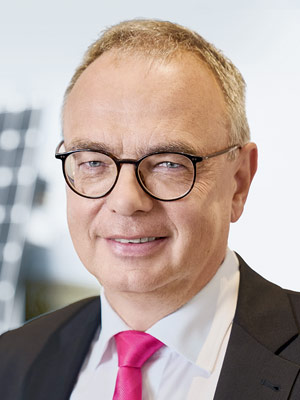So, Mr. Scharf, which “blockbuster” will it be?
Here at Rittal, we like to look at the bigger picture. After all, the digital and energy transformations in particular go hand in hand.
What will be the “hottest game in town” during the 2020s? That’s the million dollar question. Will it be comprehensive digitalization focusing on Industry 4.0? Will it be the development of the healthcare market? Or could it be transforming the way we generate, store and distribute power? Uwe Scharf, Managing Director Business Units and Marketing at Rittal, discusses this issue.
Text Ulrich Kläsener ––– Photography

Uwe Scharf
Managing Director Business Units and Marketing at Rittal
So, Mr. Scharf, which “blockbuster” will it be?
Here at Rittal, we like to look at the bigger picture. After all, the digital and energy transformations in particular go hand in hand.
Is that why Rittal created its new Energy & Power Solutions business unit in 2020?
IT needs energy and the energy industry needs IT. The one is now inconceivable without the other. Even turning energy systems into a smart grid requires intelligent networking between the various facilities. Having said that, the energy sector on its own is a highly attractive growth sector. The aim of our new business unit is to further develop and improve solutions in dialogue with our customers, and to bring them to market even faster.
So we’ve got power and data, and both need to be securely housed. What is the extent of the Rittal portfolio for energy storage?
Let’s put it like this, Rittal offers the ideal integration solution for any storage application. After all, our portfolio includes a whole host of standard products that are tried and tested in industry. These include bayed enclosure systems, standardised containers, distribution enclosures, climate control equipment – from fan-and-filter units to chillers – and monitoring solutions, all perfectly coordinated and combined in each individual case.
What does your new business unit contribute to this?
We have many years of expertise in the energy market and a well-developed range of products and services – from enclosure, power distribution and climate control technology to IT infrastructure solutions and Eplan software solutions for system planning. We also offer a global service. Consequently, we already cover countless applications, and we’re embracing the challenge of breaking new ground and making our climate control units part of an efficient smart DC grid. As part of the EU’s AREUS research project, for example, we converted our Blue e+ series of cooling units – which already consume 75 per cent less energy than conventional products – to DC operation. The patented hybrid process is the only one of its kind anywhere in the world.
Not many people are aware of this, but Rittal is also a world market leader in enclosure technology for wind turbines, isn’t it?
That’s right. However, our solutions can be found in all kinds of power generation plants, in substations, in low-voltage switchgear in the charging infrastructure for electric vehicles and in energy storage applications.
The energy revolution is impossible without energy storage systems. The reason for this is very simple. A continuous, stable power supply depends on intermediate storage, because green electricity is generated from the sun and wind, that is to say on a discontinuous basis.
Development work in this field is focusing on everything from widely available button cells and lithium-ion batteries for electric vehicles to new buffer technologies in the form of artificial atolls, concrete spheres and limestone mountains. Gigantic liquid batteries are even currently being built in underground caves in the far north-western corner of Germany. But it’s when structural and procedural engineering – that is to say new materials, new production processes and new digitalization methods – come together in a holistic approach that things get really smart, as in the case of pioneering Mercedes-Benz at its long-standing site in Sindelfingen.
The new Factory 56 is establishing the age of carbon-neutral automobile production thanks to enterprising energy architecture. It is demonstrating that energy storage systems will provide more than just a storage function in the future. They will also play a key role in smart networking with decentralised energy generation facilities. Only if photovoltaic systems, wind farms, micro-CHP plants and other energy generators, consumers and storage systems are linked and controlled digitally is it possible to perfectly synchronise energy consumption and generation in households, commercial enterprises and industry.